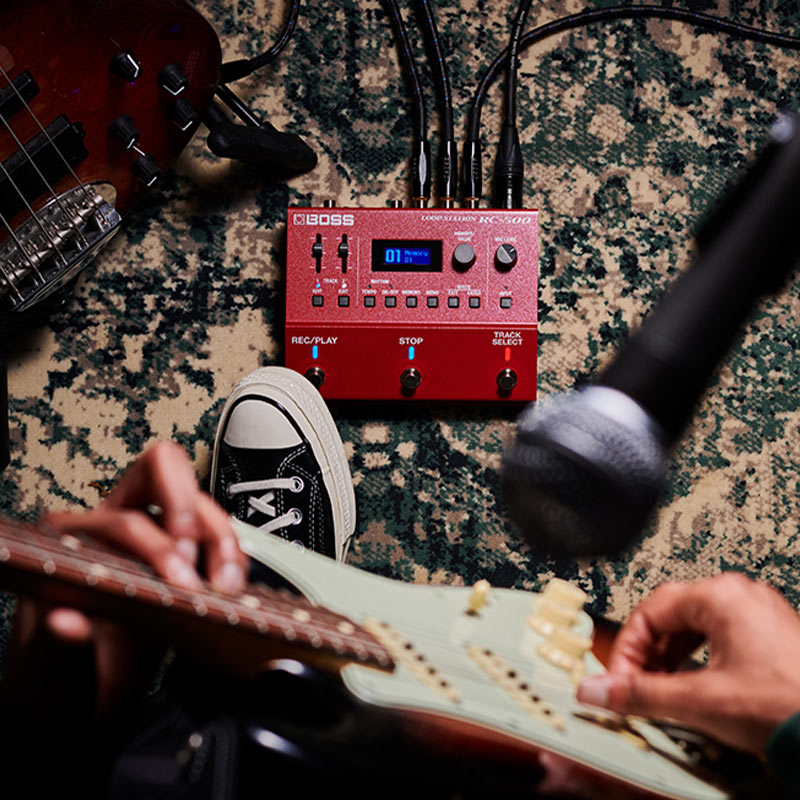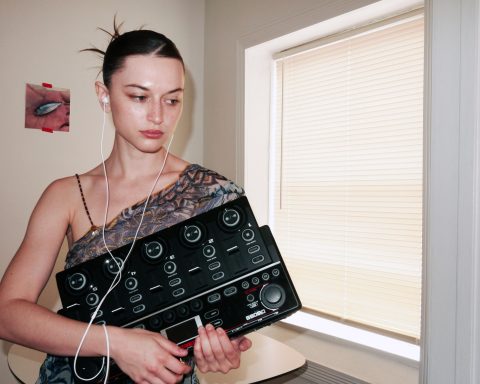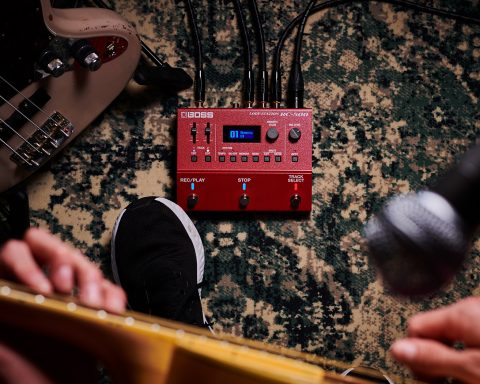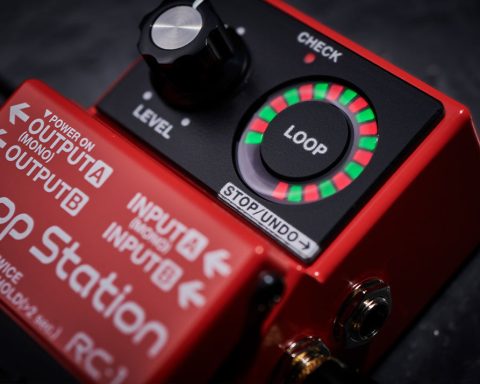Imagine this: You’re in your practice space, or you’re at home, and you’re jamming on a riff that you know has potential, but you can’t get the band together to work on it. So, you step on your loop pedal, record your phrase, and now that riff is playing back at you. Now, you add a lead melody over it and throw in a few more layers. Maybe you sprinkle some delay or reverb-drenched swells while you gradually turn the volume knob on your guitar or throw in a percussive palm-muted riff. Suddenly, it feels like a whole band is behind you, and you’re jamming with multiple guitarists. Your riff is now a fully fleshed-out song. Let’s break down everything you need to know, from choosing the best Loop Station to getting the most out of your loops.
The Power of the Loop
The power of a loop pedal is one of the main reasons electric guitarists love it; they open up your writing and recording sessions and can be a valuable live-playing partner as you can jam with yourself! Whether practicing, songwriting, or performing live, a loop pedal with an electric guitar can change how you play, write, and record.
From bedroom guitarists to stadium headliners, loop pedals have become essential tools for electric players. If you’ve ever watched guitar players like Tash Sultana, Ed Sheeran, Radiohead’s Ed O’Brien, King Crimson’s Robert Fripp, or Polyphia’s Tim Henson build soundscapes on stage, you already know how loopers can take tracks and riffs to incredible places.
So, where do you start with a loop pedal for electric guitar? What are the best loop pedals for electric guitar? Who uses a loop pedal on their electric guitar? Get ready to find out.
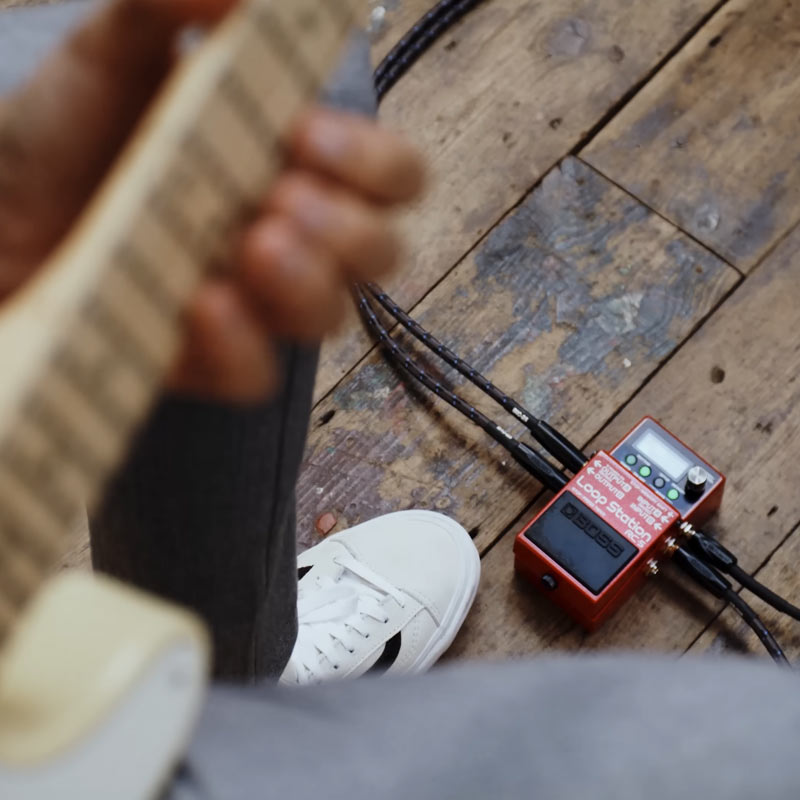
Loop Pedals Basics
A loop pedal is a guitar pedal that lets electric guitarists (as well as acoustic guitarists, beatboxers, and vocalists) record, layer, and trigger their sounds and then loop them as you go. With one stomp on your loop pedal, you can capture a rhythm part, stack lead lines, layer over ethereal effects, and even capture vocal hooks if you have a loop pedal with an XLR mic input. A loop pedal lets you jam as if you’re in a full band.
How a Loop Pedal Works
The core function of a looper follows a simple process: recording → playback → layering. Everything boils down to these three essential elements, forming the foundation of looping.
Your looper pedal records a guitarist’s performance, plays it back in real time, and allows additional layers. The process includes recording a phrase, looping it continuously, and overdubbing new parts. Advanced loopers offer undo/redo functions, tempo syncing, and visual indicators for precise timing.
- Record: Step on the footswitch and start playing your phrase, whether it’s a riff, chord progression, or a lead melody – think of the lead guitar line in Smashing Pumpkins “Today” and the chords underneath it. If you’re using the BOSS RC-1, RC-5, RC-10R, or RC-500, tap the footswitch once to start recording on the 1 beat. Press again to stop, and you’ll have a seamless loop. Pro tip: Timing is key – sloppy loops can cause gaps or timing issues, so make sure you’re starting on the 1 beat. Try counting 1,2,3,4 each time.
- Playback: Once recording stops, the pedal will repeat your recorded phrase in an infinite loop. This allows you to build an entire arrangement by layering elements such as rhythm guitar, lead lines, and effects-driven textures. Loopers like the RC-5, RC-10R, and RC-600 have stored loops and give you the ability to recall them, which is perfect for live looping your electric guitar and recalling specific phrases that are difficult to recreate live.
- Layer: Loop pedals allow electric guitarists to build a wall of sound by adding melody or lead lines, additional chords, or ambient textures. The RC-600 has multi-track looping, so electric guitarists have control over different parts of their loops. Keep layering your tracks so you get the sound you want!
Floor-Based and Tabletop
For electric guitarists, floor-based loopers are the way to go, but tabletop loopers have their place too. Here’s the difference between floor-based vs tabletop loopers :
- Floor-based loopers: These are foot-controlled and hands-free. Models like the BOSS RC-1, RC-5, and RC-600 let you loop with both hands on your guitar, and you trigger the loops with your feet.
- Tabletop loopers: These are used by beatboxers and vocalists. They’re the best loopers for vocalists because you use your hand to trigger the loops.
The BOSS RC-505mkII is a great example and is the industry standard looper used by beatboxers, vocalists, and multi-instrumentalists. Electric guitarists might not use tabletop loopers as much, but they can also be helpful for studio-based looping.
Setup and Signal Chain
For electric guitarists integrating their looper into their rig, the typical setup is:
Guitar → Drive/Distortion Pedals → Modulation (Chorus/Phaser) → Delay/Reverb → Loop Pedal → Amp
"Placing a looper last in the chain ensures all effects are recorded within the loop and won't be altered when switching settings mid-performance."
When using a looper, the signal chain order is key. Here’s a recommended setup, which is the “regular” way or most commonly accepted:
Guitar → Drive/Distortion Pedals → Modulation (Chorus/Phaser) → Delay/Reverb → Loop Pedal → Amp
- Placing a looper last in the chain ensures all effects are recorded within the loop and won’t be altered when switching settings mid-performance.
Pro tip: Watch out for feedback when looping distorted tones, especially at high volumes. Using a noise gate or adjusting amp positioning away from your guitar pickups can prevent unwanted noise from creeping into your loops.
How Do Electric Guitarists Use Loop Pedals?
There are many ways to use a looper with your electric guitar. Here are some examples:
Creating Rhythm Backing Tracks
Instead of a band, loopers allow you to record rhythm parts and solo over them—perfect for practice, songwriting, and live performance.
Perhaps the most famous video of an electric guitarist using a loop pedal is one from Tash Sultana. This video got Tash noticed and propelled their career into the stratosphere, gaining traction across the internet and going viral thanks to the fact it was just Tash, a guitar, and a loop pedal.
Building Soundscapes and Ambient Layers
Ed O’Brien and David Torn use loopers to create atmospheres. You can create lush, cinematic sounds that fill the space by layering delayed notes and swells. Watch how O’Brien loops the atmospheric sounds on “Idioteque” then leaves the loop running while he sings over it.
Practicing Lead Guitar and Improvisation
Loop pedals are great for practicing solos over custom backing tracks. Record a chord progression, improvise, and refine your technique and phrasing.
Integrating Effects and Pedalboard Creativity
Electric guitarists can use additional pedals like delay, reverb, and modulation. These effects interact with the looper to create evolving performances.
Which Guitarists Use Loop Pedals?
Many famous electric guitarists use loop pedals to enhance their performances, whether to create soundscapes, layer lead, and rhythm parts, or compose full tracks live. Some electric guitar players who use loopers are:
Tash Sultana uses a mixture of electric guitar looping and vocal loops to create a signature sound that has inspired a new generation of loop pedal users and guitarists. This showcases that you don’t need a full band to create an entire sonic palette—you can do everything alone.
Perhaps one of the most recognizable faces of guitar these days, Tim Henson of Poylphia uses loops and layer effects for intricate melodies and harmonies that give the impression that multiple guitar players are playing alongside him.
Rabea Massaad uses loops in ambient and heavy riff-based compositions to help him write songs and demo equipment.
Julien Baker creates entire songs using a loop pedal and sings over the top of them, using simple repetitive loops to create emotion-heavy ballads and gig entirely on her own. Watch her command the attention of the crowd in this incredible rendition of her song “Sprained Ankle.”
Ichika Nito loops harmonics and clean tapping lines for complex compositions and then layers an entire studio’s worth of instruments over the loop!
Yvette Young (Covet) loops tapping sequences and chord voicings and then plays over them with an additional guitar to help with transitions between songs. Skip to 3:30 to see it in action.
Thiago Ramalho is a pioneer in showcasing what a looper, particularly a BOSS Loop Station, can do. Ramalho loops guitar sounds and vocals to create incredible compositions live in front of a crowd.
Mateus Asato layers rhythm and lead parts with a looper and creates songs with just a looper pedal on an electric guitar.
What is the Best Loop Pedal for Electric Guitarists?
There’s never a right or wrong answer, but when choosing the best loop pedals from BOSS, there are five industry-standard options for electric guitarists. Here’s why they’re the best and most popular loopers for electric guitarists
BOSS RC-1
- Ideal for: Beginners, practicing riffs, and simple live loops. This is the industry standard entry point and one of the most iconic loop pedals for electric guitarists. If you’re starting out looping, get this and never look back.
- Features: 12 minutes of stereo recording, visual loop indicator, compact and durable.
- Benefits for electric guitarists: This is a simple, no-frills pedal for trying out looping ideas without complex settings. Again, it is the industry standard and easiest way to start looping.
BOSS RC-5
- Ideal for intermediate guitarists and live performers, using delay/modulation effects in loops.
- Features: 32-bit sound processing, 13 hours of recording, 99 memory slots, built-in drum patterns, and USB for backing up loops.
- Benefits for electric guitarists: Loops with rhythm backing perfect for live performances.
BOSS RC-10R
- Ideal for: Guitarists who want drum patterns with looping.
- Features: Built-in rhythm engine with 280+ styles, two-track looping, 99 memory slots, and MIDI compatibility.
- Benefits for electric guitarists: Great for solo players who want backing beats for looping lead lines and rhythm sections.
BOSS RC-500
- Ideal for: Advanced players, singer-guitarists, and live musicians wanting more loop control.
- Features: Dual stereo tracks, 32-bit sound quality, built-in rhythms, independent track controls, XLR mic input with phantom power, MIDI, USB for WAV file import/export.
- Benefits for electric guitarists: The RC-500 offers multi-layered loops, separate track control, and high-end sound processing in a compact, gigable format. The XLR input is perfect for electric guitar players who also use vocals in their loops, and the built-in rhythms and MIDI control open up a world of live performance and songwriting possibilities.
BOSS RC-600
- Ideal for: Professional-level guitarists, those experienced with looping electric guitar, and those who want the absolute best possible looper.
- Features: Class-leading sound quality with 32-bit AD/DA and 32-bit floating-point processing, six simultaneous stereo phrase tracks, easy-to-use onboard control with nine freely assignable footswitches, and three pedal modes. You also get many onboard effects with 49 Input FX and 53 Track FX types and the ability to use four at once in each section to reduce your pedalboard.
- Benefits for electric guitarists: This is the ultimate looper for professional-level electric guitarists, designed for anyone to quickly use and get to grips with. You have 200 onboard rhythm patterns and 16 drum kits to create complete tracks. Two XLR mics so you can even sing along with your loops, and you can essentially use this as an entire recording platform to create music. This is like having a whole band in a box.
Tips for Getting Started with Loop Pedals on Electric Guitar
Once you get the hang of it, loop pedals are so much fun. Here’s a quick start guide for you.
Use a Metronome or Rhythm Guide: If your looper has built-in drum tracks, use them. Otherwise, practice with a metronome, as timing is key.
Nail Your Start and Stop Points: Always start and end loops on the first beat of a measure. Count 1,2,3,4, in your head if there’s no metronome or drum on your looper.
Don’t Overload Your Loop: Too many distorted layers can sound muddy. Keep loops clear, and try not to have “dirty” or incorrect loop phrases, as you’ll get annoyed with them when you hear them for the 50th time. Just delete the last take and try again.
Manage Feedback and Noise: Position your amp away from your pickups and use a noise gate if needed.
Try Panning and Dynamics: Swells, fade-ins, and expressive playing will create more interesting loops.
Just have fun practicing. Looping with an electric guitar requires timing and precision, but it’s a lot of fun. Learn to stop and start loops and trigger sounds to play live confidently.
"Using the RC-500's dual-track looping, you can record different song sections at various intensities, starting with a clean rhythm and then adding overdriven lead parts for dynamic build-up."
Advanced Looping Techniques for Electric Guitarists
Once you’ve mastered the basics of using a loop pedal and want to expand your sound and explore what a looper can do, it’s time to graduate with the more advanced techniques. These will set you apart from other guitarists using loop pedals.
Here are some more advanced techniques electric guitarists use when adding loop pedals like the BOSS RC-1, RC-5, RC-10R, and RC-500 to their rig.
Layering with Dynamics
Not all loops should be at the same volume. Start with a quiet rhythm loop, then build layers progressively. Using the RC-500’s dual-track looping, you can record different song sections at various intensities, starting with a clean rhythm and then adding overdriven lead parts for dynamic build-up. Or even use drop outs, where you stop a loop and then trigger it when the chorus hits!
Using Effects in the Signal Chain
Since electric guitarists often use multiple guitar effects pedals, understanding where to place your looper in the signal chain is crucial—which I have highlighted above—but you can use the placement of the looper in your signal chain uniquely to get different sounds.
Here are two standard setups:
- Before delay/reverb: The entire loop will be affected by delay, creating an ambient, spacey feel.
- After delay/reverb: Each looped layer keeps its original effect setting, giving more clarity and separation.
The BOSS RC-5 and RC-500 allow you to incorporate external effects into different layers, opening up new sounds and sonic effects.
Looping Lead and Rhythm Separately
On pedals like the RC-500, you can use its dual tracks to record rhythm on one track and lead parts on the other. This lets you control the volume separately, fade out the rhythm while soloing, or switch between sections for a more dynamic and responsive performance that conveys the emotion of your playing.
Syncing with Built-in Drums
The RC-10R’s integrated rhythm engine is perfect for guitarists who want live drum backing with their loops. Choose from over 280 rhythm styles and record in sync, creating a full-band feel without needing a drummer and interacting with it just like you would a drummer!
Creating Soundscapes with Swells and Reverse Loops
Use volume swells with your delay/reverb pedal and loop them to create cinematic, atmospheric layers. The RC-5 and RC-500 feature reverse looping, allowing you to record a riff and play it backward for an experimental, otherworldly sound that sounds ethereal and cool.
Frequently Asked Questions about Loop Pedals for Electric Guitarists
Where should I place my loop pedal in my signal chain?
It depends on how you want your loops to sound and whether you want them to have effects on:
- At the end (after effects): This is the most common setup. Your loops will capture the exact tone you create with your FX pedal, such as an overdrive, delay, or reverb. Each new layer will keep its effects intact when you loop it.
- At the start (before effects): This is less common because the looper will only loop the clean sound when you turn an effect off.
Below is the recommended setup. This setup ensures that each recorded layer keeps its tone and effects, giving you the most flexibility when looping.
Guitar → Overdrive/Distortion → Modulation (Chorus/Phaser) → Delay/Reverb → Loop Pedal → Amp
"The BOSS RC-500 is great for gigging since it offers dual-track looping with independent control, making it easy to switch between song sections."
Can I use a loop pedal for live performances?
Yes, you can use a looper for live performances, and many guitarists do. The BOSS RC-500 is great for gigging since it offers dual-track looping with independent control, making it easy to switch between song sections. The RC-10R adds built-in rhythms, perfect for solo performers who want a backing band.
How do I prevent feedback when using a looper live?
- Keep your amp positioned away from your guitar pickups.
- Use a noise gate pedal if you’re layering high-gain tones.
- Avoid excessive looping of distorted sounds, as too much gain can create unwanted noise buildup.
What’s the best looper for beginners?
The BOSS RC-1 is widely regarded as the best looper for beginners. It’s a simple, one-button looper with an easy-to-read display, making it great for first-time loopers.
How do you get the timing right on a looper pedal?
Get the timing on a looper pedal by counting “1,2,3,4” before recording and pressing the footswitch precisely on the “1” beat. Use a metronome or built-in drum patterns for consistent tempo. Start with simple loops and refine timing using undo/redo functions. Visual indicators help track loop position.
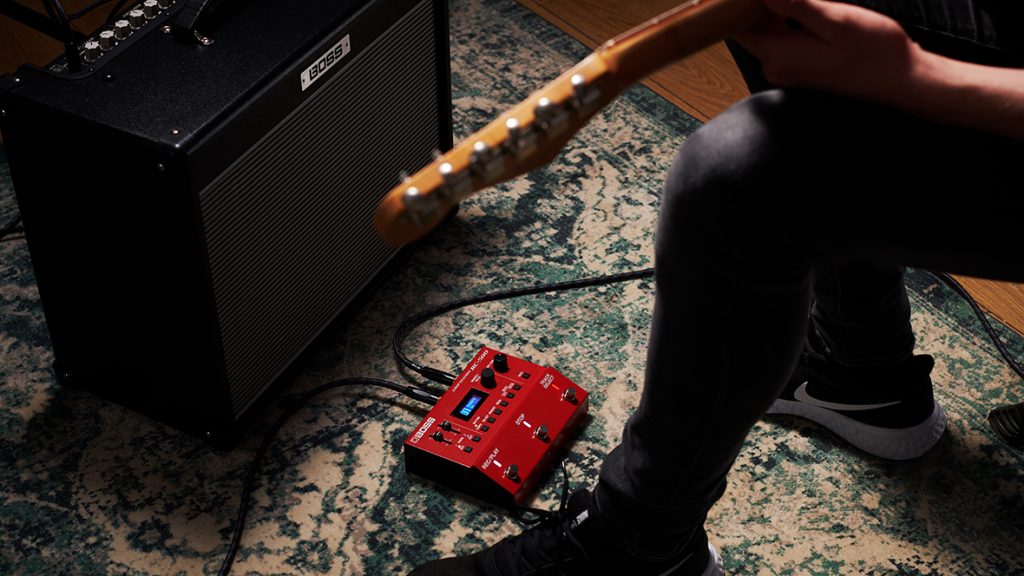
Fun is the Formula
Loop pedals are a must-have for electric guitarists, as they open up many possibilities in songwriting, playing live, and even improving your skills. Plus, they’re just so much fun. Whether you’re a beginner looking to practice, a songwriter building layered arrangements, or a live performer creating immersive soundscapes, there’s a looper for you.
If you’re starting looping as an electric guitar player or you’re looking for the best looper for electric guitar, start with the RC-1, then move to the RC-5 or RC-10R, and explore the full potential of the RC-500 and RC-600 when you’re ready for advanced looping. Try them all and see which one suits you. Whatever your style, there’s a BOSS looper for you and your electric guitar.
Want to dive deeper into looping? Visit our Loop Station hub for more insights, tips, and resources.
